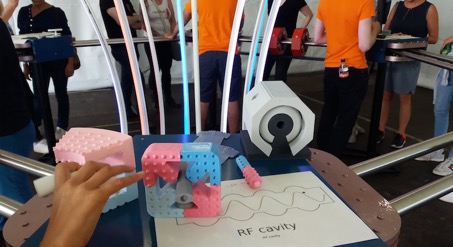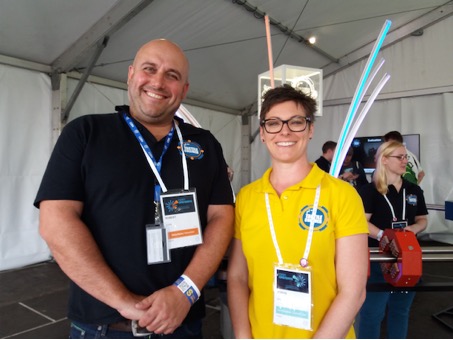During the EPS 2019 conference held in Ghent last summer, Rob Appleby, Chris Edmonds and Robyn Watson were awarded the Outreach Prize of the EPS High Energy Physics Division " for the Tactile Collider Project that brings particle physics to blind and visually impaired schoolchildren through touch and sound."
On 14 and 15 September 2019, Tactile Collider was installed at the CERN Open Days. These were attended by 6,000 visitors who had the opportunity to discover the project and it’s unique way of delivering science.
What is Tactile Collider?
The installation consists of a series of metal tubes of around 2 metres in length which are assembled in a ring representing the CERN Large Hadron Collider, a circular particle accelerator of almost 27 km in circumference. Placed within this tube network are tactile representations of the (RF) cavities and dipoles which are made from different materials to encourage participants to touch and explore the accelerator model. Other 3D-printed elements show magnets and the movements of particles inside the accelerator. Participants are also able to touch tactile diagrams to bring to life the Higgs boson.

Tactile Collider invites participants to touch the elements to grasp the principles of a particle accelerator
A clash outside the collider
In 2014, Manchester welcomed "Collider", a temporary exhibition looking at the discovery of the Higgs boson. When two blind visitors asked if there was a way for them to access the exhibit the idea for Tactile Collider was born.
Dr Rob Appleby (University of Manchester) worked alongside Dr Chris Edmonds (University of Liverpool) to look at ways of delivering particle accelerator physics to a visually impaired audience (VI). Using an online forum they asked for people with visual impairments to give advice on what their expectations were in similar situations and what could be suggested to improve facilities in exhibitions. Robyn Watson, a teacher of the visually impaired replied and she became the link between the scientists and the children.
It took 6 months to develop the Tactile Collider installation. In 2017, a prototype was created at Cockcroft Institute and Robyn and her students worked alongside Rob and Chris to finalise the tactile objects and delivery of the project. Later in the same year, a "soft launch" was organised as test event at St Vincent’s School in Liverpool. Robyn went there to observe the participants and she gave feedback again.
In 2018, the Tactile Collider team organised several events throughout the UK: science museums, schools, music festivals. Tactile Collider was taken on tour with the hope of being accessed by as many students as possible. It was intended for children with VI but also worked for a non-VI audience to raise awareness of visual impairment and to make science accessible to all. The project evolved every time it was presented and encountered huge success everywhere.
Parents of the children who attended have explained their delight in feeling that their children can access the same information as other pupils. Tactile Collider is designed to be accessible for children with VI, however this also makes it an exciting project for all students and adults who are interested in discovering science. It simplifies complicated physics concepts and breaks them into smaller, digestible parts.
The project also brings together scientists and children with VI, this is a key aspect of the programme and allows students to connect with someone working with science everyday. For the children with VI having subject specialists like physicists explaining the science gives them the opportunity to explore ideas for further study and employment that they may otherwise have felt wasn’t possible.
Robyn, in her work as teacher of the visually impaired, works with teachers to make their lessons accessible to children. She teaches them that there is value in diversity and inclusion.
Before receiving the 2019 EPS HEP Outreach Award, the Tactile Collider team won the "2018 University of Manchester People’s Vote for the Faculty of Science and Engineering’s Better World Showcase" and was "Highly Commended in the Making a Difference Awards for Social Responsibility 2018 for Outstanding Contribution to Equality, Diversity and Inclusion". They have since won the "RNIB 2019 Innovator of the Year Award" in the UK.
The future of the Tactile Collider
Tactile Collider would like to inspire a generation of children with visual impairements as well as members of the general public. To allow them to engage with high level learning in places like schools, science festivals and museums.
The next step is to develop new projects, organise events in the UK and beyond. Rob, Chris and Robyn are currently planning a workshop to train educators on how to deliver the science behind Tactile Collider and on how to include learners with VI in their lessons and workshops.
So stay tuned for more news about the Tactile Collider team. And let yourself be inspired by their enthusiasm to spread science to everyone!

Rob Appleby and Robyn Watson participated in the CERN Open Days
and welcomed almost 6,000 visitors to explore Tactile Collider
The Tactile Collider team
- Rob Appleby: Physicist at the University of Manchester and the Cockcroft Institute.
- Robyn Watson: Teacher for visually impaired children at Bolton Sensory Support Service.
- Chris Edmonds: Physicist at the University of Liverpool and the Cockcroft Institute.
 You can listen to the article here: https://tinyurl.com/tmwvmuo
You can listen to the article here: https://tinyurl.com/tmwvmuo
(Robyn Watson reading)
author: Gina Gunaratnam